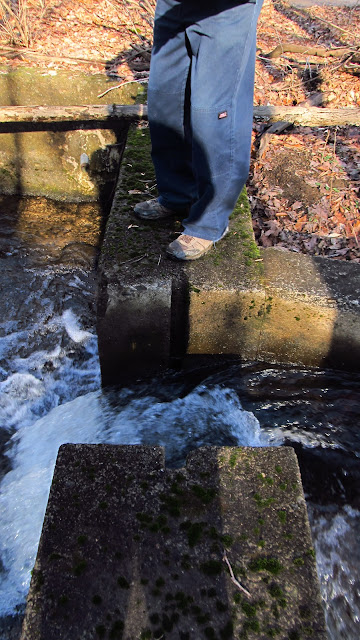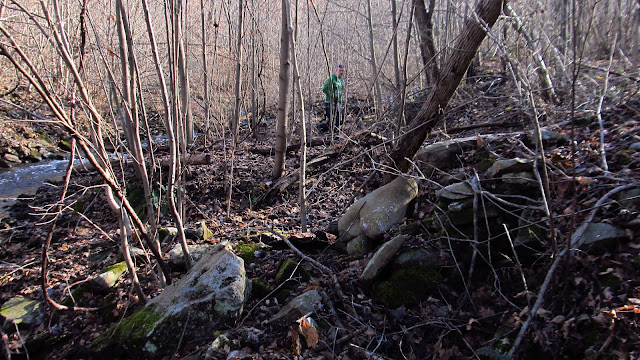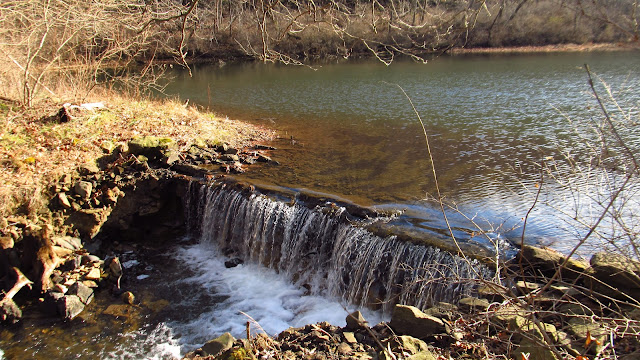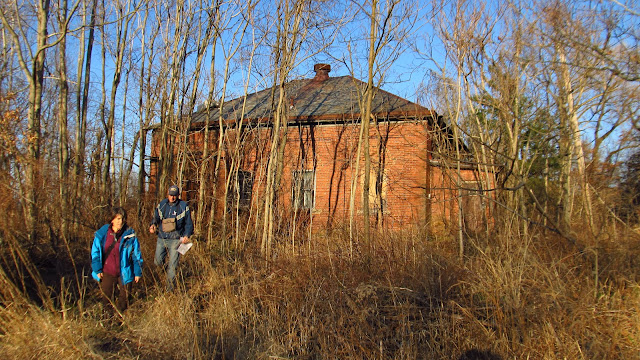Today Lou and I had a great opportunity to check out an incredible old reservoir and the ruins of the Lemont No. 2 Mine and Coke Works. Thank you Rose-Marie and John for showing us around! It was definitely a fun day.
I really haven't done much with old reservoirs, other than mentioning them when they applied to old coke works. This reservoir appears to have mostly supplied municipal drinking water. There were three reservoirs involved in this system and they kind of stepped down Chestnut Ridge using an impressive series of cut stone spillways and dams along Coolspring Run. The reservoirs are not completely unrelated to coal and coke; during the storm of July 1912, the reservoirs overflowed their dams and sent water rushing down the ridge to the villages below. The Lemont No. 1 and Superba Mines were completely inundated, resulting in the deaths of 18 miners, 3 in Lemont, and 15 in Superba. The Superba Mine would never go into operation again, but Frick had Lemont No. 1 running again by the end of the year.
Dating this reservoir is also proving to be difficult. The 1900 topographic map shows the lowest reservoir but not the higher ones. Also, this site is the location of Coolspring Furnace which was constructed ca. 1820 by Thomas McKean. According to Richard Parks, the stones from this furnace were used in the construction of the lower dam. We searched but we were not able to locate the remains of this furnace. A nearby limestone mine that is encroaching on the area may have buried the remains, or we might have just missed them. The site is pretty thick in areas, even in the winter. The furnace ceased operations around 1860 due to a shortage of water in the area, which is an exceptional run for an iron furnace. So we know the furnace stone was used to construct the first dam. A 1908 Morning Herald article mentions that the reservoir was used to supply water to Uniontown, and the supply wasn't high enough. The upper reservoir appears in the 1941 county map. The limited resources I have access to regarding reservoirs does not allow me to pinpoint any specific dates for these projects.
 |
1900 Uniontown quad topographic map showing the lower Coolspring Reservoir. |
 |
Uniontown Morning Herald Saturday, August 15, 1908 |
 |
1941 Fayette County map. |
This is what's here now:
 |
We started seeing nice stone walls as soon as we started climbing the hill. |
 |
Not too long after, we came across this small concrete dam and spillway. |
 |
There are slits in the concrete on the spillway that look like they could have been used to direct the flow of water. Directly above here is a confluence of three small streams. |
 |
Close up of the "slits". |
 |
The water appears to have eroded this spillway. |
 |
Looking upstream. |
 |
These appear to be the ruins of another dam. |
 |
The other side of the stream. |
 |
The back side of the dam. |
 |
More of the spillway. |
 |
This is at the top and what we're going to call the middle reservoir. There's another one above here. This is a huge concrete dam. |
 |
Looking across what's left of the reservoir. Notice the wall in the background. This would have been the full capacity of the reservoir. |
 |
This is what remains of the spillway for this reservoir. |
 |
Looking downstream from the spillway. |
 |
Remaining stone along the spillway. |
 |
Stone floor of the spillway. |
 |
Waterfall below the middle reservoir. |
 |
Heading back above the middle reservoir. Right now there is one pipe that leads down to the limestone mine. Other than that, these reservoirs are unused. |
 |
This is the wall we were looking at from the other side. |
 |
The spillway from the upper reservoir to the middle reservoir. |
 |
What's left of the upper reservoir. |
 |
Upper reservoir spillway. |
 |
This trail leads up to the Summit Inn on Route 40. About five miles away. |
 |
Lower reservoir spillway. |
Lemont No. 2
All these years I have had my Lemont's mixed up. I did a post a few years ago on what I thought was Lemont No. 2 but it turns out it was Lemont No. 1. So if this history sounds familiar, that's why. The link to Lemont No. 1 will take you to the post but I need to get back in there and change it.
Regardless, this is an interesting site. We located three drift entrances. Two are flooded, and the one that isn't is sealed about 20 feet back. One of the entrances is horribly leaking aluminum tainted water, but it just disappears and goes back underground. We all know this stuff comes out somewhere though...
The engine house is still extant and actually in really good shape. The coke ovens are either buried or removed. We did locate the top of two or three. The site looks like it's used for several different purposes. It was used at one point as a processing plant for recovering useful material from slate dumps, and it looks like wood mulch was made here. It's a pretty expansive site, and its later use in light industry left a good portion intact. That being said, most of the original structures are gone and have been replaced by buildings to serve its later needs.
Lemont No 2. was listed as a new mine in the 1890 Reports of the Inspectors of Mines. It was operated by the McClure Coke Company and initially contained 300 ovens. 50 more ovens were added in 1895 and 350 would be the final oven count during the plants lifetime. McClure operated this plant until 1900 when the plant was taken over by the H.C. Frick Coke Company. Frick would operate Lemont No. 2 until at least 1920. Throughout the 1930's, and until at least 1945 the plant was operated by the Lemont Coal and Coke Company. In August 1948 the Pittsburgh Post Gazette reported that the King Coal & Coke Company fired 100 of the ovens after "leasing the property from Charles H. Friday". Charles Friday purchased the plant in March 1948 from the H.C. Frick Coke Co. This suggests that the Lemont C&C Co. was just leasing the plant from Frick. The newspaper article states "The Firm (King) spent three weeks on reconstruction work and expects to have the plant in full operation with 300 beehive coke ovens September 15".
In 1966 Charles Friday, who also had coal interests in Bobtown, Greene County, ran an ad in the paper telling hunters and the general public that the land where Lemont No. 2 is located is posted as No Trespassing.
 |
October 5, 1966 - Uniontown Evening Standard |
 |
This is a portion of the Lemont No. 2 mine map as it was shown in the 1893 Reports of the Inspectors of Mines. It clearly shows the 300 original ovens. |
 |
A portion of the mine map showing the entry and the haulage tracks. |
 |
Portion of the mine map showing the engine house. The boiler house is gone. |
And this is what it looks like today:
 |
The engine house. |
 |
A little further down was this open shed. These are belts for something. |
 |
Old junk gas trucks over by the slate dump. |
 |
Slate and ash dumps. |
 |
Cap on a shaft. |
 |
Massive old footer. |
 |
The main mine entrances. |
 |
The right portal. This is a mess of aluminum drainage too. |
 |
The left portal. Dry and sealed. |
 |
Exposed left portal. |
 |
Exposed right portal. |
 |
Another shot of the left. |
 |
Remains of a fan house above the entries. |
 |
The tunnel of love. Side entry, completely polluted with aluminum drainage. |
 |
Old steel cable laying around. |
 |
More recent tree mulcher. |
 |
We assumed this spins the trees, sends them down the belt and mulches them. |
 |
The remaining coke oven block. |
 |
This is the extent of the remaining ovens at Lemont No. 2 Coke Works. |
 |
Another piece of more modern machinery. |
 |
Huge Manitowoc dragline. |
 |
This is part of the machinery used to process slate dumps. |
 |
Old Armstrong coal stove. |
 |
A massive pile of reclaimed coke. |










































That slit is called a weir. Nice change for you to show us a water system. There's one near Ronco, too!
ReplyDeleteThanks for posting. Very interesting.
ReplyDeleteNice someone cares about lemont history
ReplyDeleteMy fathe worked for Uniontown Water Company and brought me a baby turtle from the reservoirs. Everything you say about the water supply is correct. The water was pumped from Connellsville to a reservoir at airport and then to Coolspring.
ReplyDelete